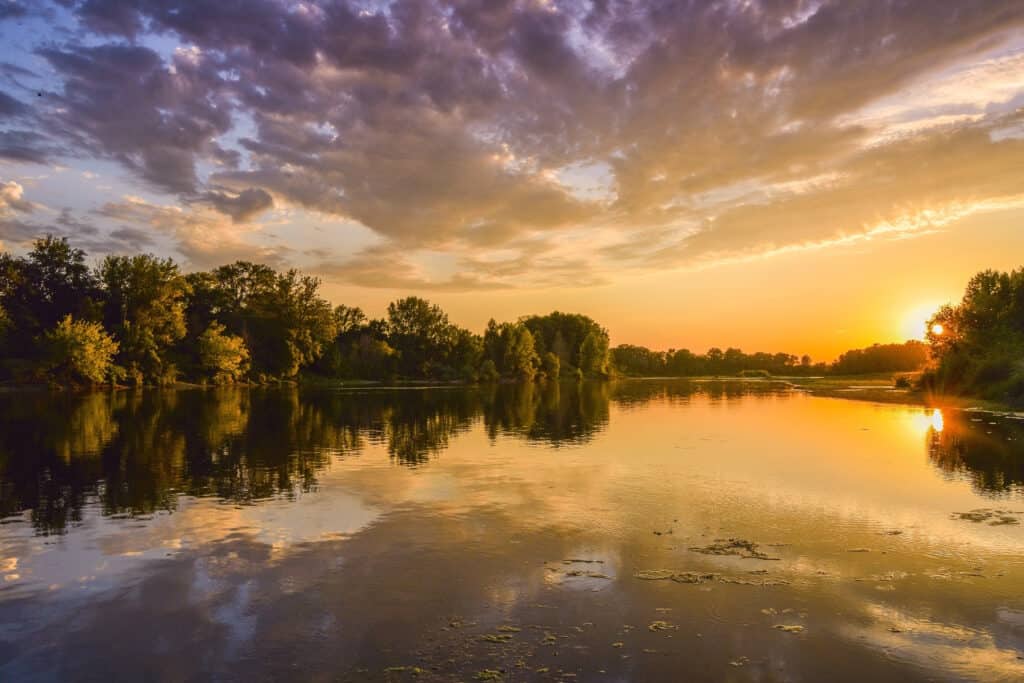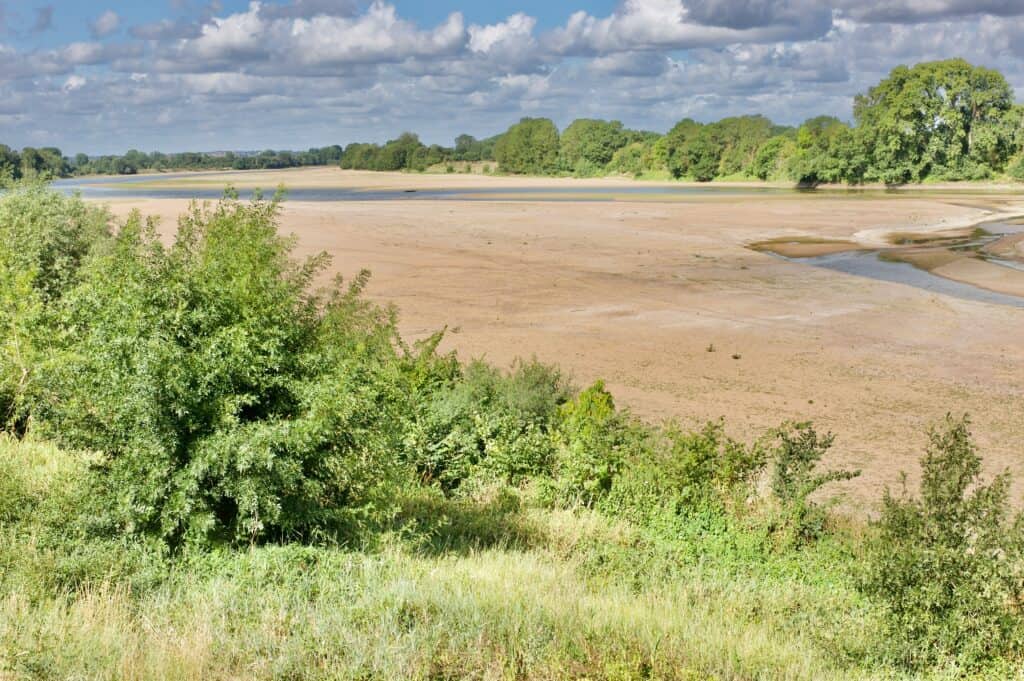The Loire Valley is famous for its beautiful chateaus (castles) on the edge of the Loire River. Tourists flock to the region each year to visit the historic castles, taste wine, and enjoy the beautiful surroundings. However, this year, things are different. An extreme drought and heat wave have hit most of Western Europe, and now many important European rivers are drying up, including the Loire, France’s longest river.
All About the Loire River

The Loire River in France when not suffering a drought.
©Suranyi Mate/Shutterstock.com
The Loire River is over 600 miles long and runs from the Massif Céntral mountains in Southeast France, and ends on France’s west coast. It empties into the Bay of Biscay in the Atlantic Ocean in the town of Saint-Nazare. Parts of the region are World Heritage Sites, meaning they have important cultural and historic significance. The river feeds over 70 tributaries and has been important for commerce for hundreds if not thousands of years.
In modern times, only a few sections of the river are navigable by today’s cargo ships, which require deeper waters. However, the city of Nantes, which sits inland about 40 miles from the mouth of the river, has an important port for the country to import and export goods. Additionally, riverboats are still used all along the river for recreation and tourism.
While it may not be as important of a river for cargo as others in Europe that are also drying up, The Loire Valley is an important region for France. As mentioned, tourists come from all over the globe to enjoy the history, wine, and art of the region. The area is known not only for wine production, but also for growing artichokes, asparagus, and delicious fruit. There are over 700 hotels in the region and 500 restaurants as well as 100 museums, and more than 700 historic monuments. According to The European Commission, services including tourism accounted for more than 60% of the area’s economy.
There are also four nuclear power plants along the river that create about 20% of France’s energy. Water from the river cools the plants, keeping the area safe. This means it is essential to the functioning of the energy supply.
The Effects of the Drought

The Loire River in France, which is currently suffering a drought following this year’s summer.
©Nathalie Stefanelli/Shutterstock.com
All over Europe, rivers are drying up this summer, and the Loire has been severely affected. Some catastrophic photos show bridges along the Loire with absolutely no water underneath. Others show a mere trickle of water you could easily hop across in a mostly dry river bed that was once a roaring flow of water that would have been quite a swim to get across. Many of the tributaries of the river are completely dry. The flow of the river is about 1/20 of what it usually is at this time of year.
And, the drought is not as bad as it could be. The French government authorized the release of water from two dams to make sure that the nuclear power plants along the river will have enough water for cooling. If one of these plants has to close due to low water levels, already high energy costs in the country will rise more.
France has already adjusted their rules for the way its nuclear power plants interact with the water of the Loire. Normally, the power plants release hot waste water into the cooler river. However, when river temperatures are already high, the release of this water is not allowed because it can further heat the water and affect the ecosystem negatively. Since mid-July nuclear power plants have been permitted to release this water despite the high temperatures in order to keep the country’s infrastructure intact. Some of France’s power plants are already offline for maintenance, so keeping these open and producing energy is essential at the moment.
Lower water levels cause heating and deoxygenation of the water. The temperature and lack of oxygen put the fish of the Loire at risk. As puddles separate from the main river, many fish become trapped. This can affect the whole ecosystem, as other animals depend on those fish as a food source. Experts say that some fish species could die off or become endangered as a result of repeated droughts in the area.
Additional to the river running dry, local springs are also dry. In many communities, people are now dependent on water trucks for their water supply to use for bathing, drinking, cooking, and more. In other areas, there are severe water restrictions in place.
What is the Cause of the Drought in the Loire Valley?
Europe had an extremely dry winter and spring. Then, this summer, there were intense heatwaves and a lack of rain for nearly two months. Most experts believe the 2022 European drought is caused by climate change. They believe it is the worst drought to hit the region in 500 years and that it is even worse than the 2018 European drought.
Climate change has caused changes to the jet stream, an important air current that influences weather conditions. These changes have caused hot and dry periods to stay over Europe for longer than usual. In the winter, the reverse will be true. A polar vortex of freezing cold air could stall over the region for longer than normal.
The Outlook for The Loire Valley
Experts believe the hot and dry conditions may continue for at least three more months. All across Europe, this will affect food supply, energy costs, and other important aspects of daily life. However, The European Commission is still evaluating the effects of this event, as it is ongoing. For now, it is likely to remain rather dry for the next few months, along with many lakes and marshes in France that have also dried up.
Famous for the chateaus along the water’s edge, the Loire River in France currently suffers from a drought due to a dry winter, spring, and summer. The effects of the drought could be devastating.
Up Next…
- Discover the 12 Largest Rivers in France
- The Worst Droughts in Human History and What Happened After
- What Happens if California Has Another Drought?
- The 12 Longest Rivers in Europe
The photo featured at the top of this post is © Nathalie Stefanelli/Shutterstock.com
Sources
- The Local fr, Available here: https://www.thelocal.fr/20220811/in-pictures-french-drought-intensifies-loire-dries-up/
- Britannica, Available here: https://www.britannica.com/place/Loire-River
- Experience Loire, Available here: https://www.experienceloire.com/loire-river.htm
FAQs (Frequently Asked Questions)
How long is the Loire River?
The Loire River is over 600 miles long.
Where does the Loire River run?
The Loire River runs from the Massif Céntral mountains in Southeast France, and ends on France’s west coast. It empties into the Bay of Biscay in the Atlantic Ocean in the town of Saint-Nazare.
What are the effects of the 2022 drought on the Loire River?
Some areas of the Loire River are completely dry. Many of the tributaries of the river are also completely dry. The flow of the river is about 1/20 of what it usually is at this time of year.
There are 4 nuclear power plants that depend on the river for cooling. If one of these plants has to close due to low water levels, already high energy costs in the country will rise more.
Some fish species could die off or become endangered as a result of repeated droughts in the area.
What is the cause of the Loire River Drought?
Europe had an extremely dry winter and spring. Then, this summer there have been intense heatwaves and a lack of rain for nearly two months. Most experts believe the 2022 European drought is caused by climate change.
Climate change has caused changes to the jet stream, an important air current that influences weather conditions. These changes have caused hot and dry periods to stay over Europe for longer than usual. In the winter, the reverse will be true. A polar vortex of freezing cold air could stall over the region for longer than normal.
Thank you for reading! Have some feedback for us? Contact the AZ Animals editorial team.






